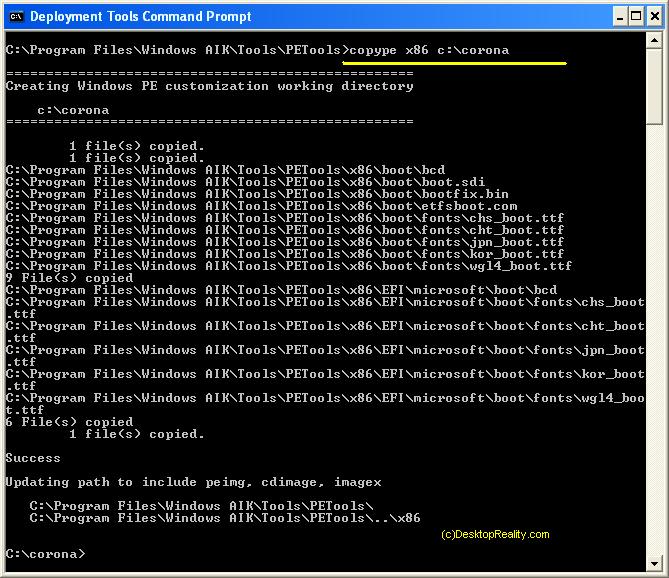Bcdboot Exe Bootsect Exe E Imagex Exe

Hi all, I'm booting WinPE via a USB HDD with 2 partitions and applying my image to the internal HDD. This works well but my images are of only the System partition and don't contain any of the boot files contained in the boot folder, so I need to use the bcdboot command to copy the boot files onto the internal HDD. My question is therefore what is the correct bootbcd command given the following. C Drive in the boot partition on the USB D Drive is the second partition on the USB containing all my images E Drive is the internal HDD that I just applied the image to.

Is it BCDBOOT e: windows /s c: Or something else. Plus do I need to CD to a particular drive before I execute the command? TIA Greg Edited October 25, 2012 by ghines. Ghines, I suspect your c: and e: are reversed. Please let us know what you learn. EDIT: BCDboot not bootBCD.
In a command prompt enter 'BDCboot /?' (no quotes) and get instructions. No C: and E: are not reversed. I boot from my USB HDD and the new HDD that is to have the image applied to is unformatted and unpartitioned. I then clean, partition, format, set active and assign the new HDD, which gives the new HDD the next drive letter E. I then apply my image to E: Have read the link but I'm still confused as to the correct BCDBOOT command and whether I should CD to a particular drive before I issue the command. Any help would be appreciated.
You only need to use BCDBoot.exe if your HDD has more than one partition. If it is a single OS partition, you don't need it. And the files that are missing in the 'source' will appear, materializing from thin air? Well lets put it this way. I can do an install with a System Reserved partition (where the boot files are located), then capture just the OS partition, redploy it as single partition and it will boot. Have there been any documented cases of where NOT using BCDBoot.exe on a single partition disk causes Windows not to boot?
From my experiences, BCDBoot.exe is only needed when you have multiple partitions with bootable OSes. @OP, you don't mention what made this image. Is it Imagex, DISM or something else? You also don't mention what OS the image is of, and if you are deploying to MBR or GPT disks. There are some conflicting documentation as to how to run BCDBoot.exe. La Vista Preliminar No Esta Disponible Excel 2010.
Running and using Windows on a flash usb. Download imagex.exe, bcdboot.exe and bootsect.exe from Windows AIK or request. Bcdboot.exe and bootsect.exe to c.
Some may say run it from the WinPE ramdisk (x: windows system32 bcdboot.exe) but I have seen other documentation saying to run it from the deployed OS path (e: windows system32 bcdboot.exe) which I've never gotten to work. You could alternatively copy it from the deployed OS to the ramdisk. Or just keep it in your WinPE image. I've also run into problems with the C: being take up already when booting into PE for imaging (except Windows 8) which I solve by using a diskpart script. It basically takes whatever is assigned to C: and changes it to something else that isn't taken.
This way there is no problem with your deployed OS being installed to a partition assigned with C:. Thanks everyone for all your input, but no one has answered my original questions. I will recap and add a bit more information that might be helpful. I'll use the MS convention for naming the partitions. I place a new HDD, unpartitioned and unformatted, into a laptop.
I boot the laptop via a USB HDD that has 2 partitions. They System Partition of the USB HDD gets assigned C while the other partition containing the images is assigned D. I now use DISKPART to prepare the new HDD, clean create par pri format fs=ntfs quick active assign. Now the new HDD has the drive letter of E. I apply my Windows 7 image to the new HDD using imagex. However this image is only of the Boot Partition and therefore does not contain a boot folder in the root directory.
To make this new HDD bootable I need to use the BCDBOOT command, but what is the correct command and do I need to run the command from a particular location? Ghines, here is an about doing a similar process as you. The article uses the BCDboot on the target system partition (D: in this case) to do the file copy and only specifies the first parameter for the command.